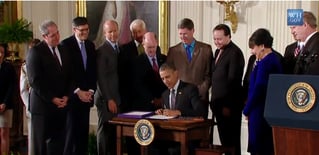The U.S. Generalized System of Preferences (GSP) program is back!
 If you’re one of the many shippers who benefited from the GSP program, then you remember vividly when the program expired at the end of July in 2013.
If you’re one of the many shippers who benefited from the GSP program, then you remember vividly when the program expired at the end of July in 2013.
U.S. businesses have paid over $1 billion dollars in tariffs that were previously duty-free since the GSP expired, according to the White House.
We posted 3 things you could do about the GSP expiring back when it expired, supporting the efforts to renew the GSP. It only took two years to see the GSP get renewed.
However, the good news is that the GSP has been extended retroactively; therefore, you can get back the money you lost on duties when the program expired.
There is a limited window on getting your money back, so we’ll cover that and how to get reimbursed for GSP duties you’ve paid below.
Passed and Signed “Trade Prefrences Extension Act of 2015” Renews GSP
On June 25th, Congress passed the Trade Preferences Extension Act of 2015. Then on June 29th, President Obama signed the bill.
Title II of the Act authorizes the GSP through December 31st, 2017, as well as making it retroactive back to its expiration on July 31st, 2013.
President Obama actually signed two bills affecting international shipping in a number of ways on June 29th. We’ll get into the other things these bill signings covered in a future blog.
Here’s a video from the White House of the president signing the bills:
Here’s a description from the White House’s blog:
Though it has a wonky name, the Generalized Systems of Preferences program (GSP) is the oldest trade preferences program in U.S. history. Instituted in 1974, GSP is designed to promote economic growth in the developing world by providing preferential duty-free entry into the U.S. market for nearly 5,000 products form 122 designated beneficiary countries and territories. In 2012, the year before the program expired, the U.S. imported $20 billion worth of products, helping developing countries to increase and diversify their trade with the U.S. and grow their economies. U.S. businesses have also paid a high price after this program expired, over $1 billion in fact, on tariffs that previously entered the U.S. duty-free. Its renewal today will help some of the poorest countries in the world, U.S. businesses, and consumers alike.
How To Get Your GSP Refund
This is quite possibly the biggest thing importers of goods from GSP eligible countries want to know: How do I get my tariff money back?
Shippers need to file formal requests for duty refunds on GSP eligible imports between July 29th, 2015 and December 28, 2015.
Many importers were very prudent, planning for the eventuality that the GSP would be renewed. These shippers marked their imports that previously were eligible for duty-free entry through the GSP with an “A+,” “A” or “A*”.
U.S. importers who designated their GSP eligible imports with the above designations during the time that is covered retroactively may get their entries automatically processed by the U.S. Customs and Border Protection (CBP).
However, it is possible that even these shippers will need to submit formal requests.
Lexology.com explains this well:
… those that have flagged interim entries may not have to file a request for repayment. CBP will reportedly, as in the past, automatically process previously filed entry forms that already contain the GSP designators “A+,” “A” or “A*.” If CBP automatically processes the entries, then importers can expect to receive their refunds 90 days after CBP concludes the liquidation or reliquidation process. It is not yet certain whether CBP will automatically process refunds because during 2014 the President removed Russia and Bangladesh from the list of GSP-eligible countries. Importers who claimed GSP benefits on their entry forms for goods from those countries will therefore not be eligible for a refund, as those items are not duty-free. CBP is currently testing to see if automatic processing is a feasible option and will issue instructions on the processing of claims most likely next week but definitely before July 29.
Don’t think you’re out of luck if you didn’t mark your GSP eligible imports as indicated above.
Lexology explains what you need to do to get your money back:
Importers who did not flag their import entry with an “A+,” “A” or “A*” must submit a “sufficient” formal request to CBP within 150 days of the reauthorization’s July 29 effective date. A “sufficient” request provides enough information to allow CBP to locate or reconstruct the entry. If the good is eligible for the GSP and the importer files a sufficient request, CBP will pay the amount owed within 90 days of the completion of the liquidation or reliquidation process. The repayment does not include interest.
To be eligible for the retroactivity provision the goods must:
Importers must file requests with CBP by December 28, 2015—180 days after the President signed the Act.


